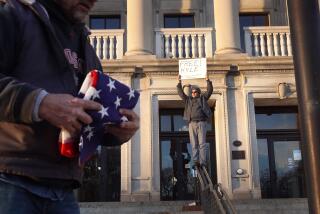An unlikely site for Civil War museum
- Share via
KENOSHA, Wis. — Not a single Civil War battle ever took place in Wisconsin.
Nevertheless, officials hope to make this city halfway between Milwaukee and Chicago home to a $15-million Civil War museum.
“Most people say, ‘Why a Civil War museum? Lincoln wasn’t born here,’ ” said Paula Touhey, director of the Kenosha Public Museum.
But six Midwestern states -- Iowa, Illinois, Michigan, Indiana, Minnesota and Wisconsin -- sent more than half a million men to battle, she said.
“When they came back to the middle west, they were changed forever,” she said.
Museum curator Dan Joyce said about 94,000 Wisconsin residents -- roughly one-in-two able-bodied men -- enlisted even though the state was established just 13 years before the war began.
“From the gulf all the way to the Atlantic Ocean, they were pretty much everywhere,” Joyce said.
Mayor John Antaramian, the driving force behind the museum, also saw an opportunity to increase tourism in an area where 11 million people are within a two-hour drive.
Civil War tourism is a lucrative industry. At Gettysburg alone, visitors spend $121 million annually, according to the Civil War Preservation Trust.
“People will ask the question, ‘Why?’ ” Antaramian said. “But the museum will affect more than Wisconsin. It will affect the surrounding states that formed the Iron Brigade.”
The Iron Brigade -- originally made up of three Wisconsin units and one from Indiana -- was considered by many historians to be the best fighting brigade in the Union Army.
Council leader Julia Robinson said the group had been receptive to the idea because of the unique vantage point museum officials planned to take.
“It was, in a sense, a battlefield among the community,” Robinson said. “A man stood up and said in his extended family he had a relative that fought for the Union and another who fought for the South. How did they patch things up, how did they go to family functions knowing that they shot at each other?”
Museum officials say they want to reveal the stories behind some of the casualties.
“It’s a story that really isn’t told anywhere because you have a museum or you have a battlefield and people are concentrating on what happened in the battle,” Touhey said.
“But what happened at home? What happened with the women and children? What happened to the farms?”
More to Read
Sign up for The Wild
We’ll help you find the best places to hike, bike and run, as well as the perfect silent spots for meditation and yoga.
You may occasionally receive promotional content from the Los Angeles Times.






